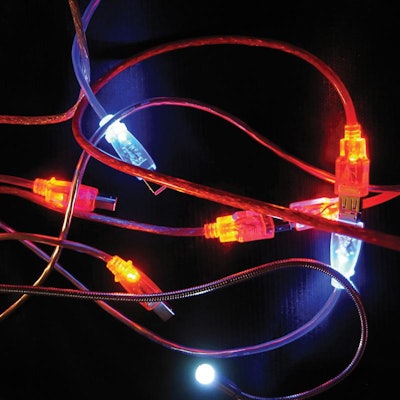Security cameras are becoming more abundant, giving users more vision into activity in all sorts of facilities. Linking these cameras often directly into corporate networks makes data accessible everywhere, so it can be used in many different ways.
Security solutions firm AES Group Ltd. (www.aes-group.com), based in Bangkok, Thailand is a big proponent of networked camera systems, installing them in many facilities throughout Southeast Asia. Nestle is one of its customers, as are numerous transportation companies. For nearly all of these configurations, AES eliminates some wiring by utilizing the Power over Ethernet (PoE) standard, which uses conventional cabling to carry power as well as communication signals.
Use of PoE can dramatically reduce network complexity. “We use a lot of Internet Protocol (IP) video surveillance, using PoE on virtually every installation,” says Henny Beeber, chief technical officer for AES. “We can use one CAT 5 orCAT 6 cable for both [local area networking] and power. Otherwise, you have to run a separate power line, which sometimes means using a separate conduit because you can’t run power in the same conduit.”
One of its most recent installations was on Thailand’s Suvarnabhumi Airport Rail Link, a 17-mile railroad that links the international airport to downtown Bangkok. The security network includes 260 security access doors and 560 Bosch IP
network cameras installed at eight local stations and the city air terminal. Data sent over Ethernet, which includes fire alarms as well as digital video recording, can be distributed to many sources. Plenty of data is collected—each train station has 120 terabytes of video storage.
PoE is beginning to gain some acceptance in industrial environments, giving users a way to install equipment anywhere they can run an Ethernet cable. An Automation World survey earlier this year found a lot of interest, but few takers. However, some equipment suppliers say that the interest is beginning to turn into some installations.
“PoE is relatively new. Phones are one of the primary products using it to connect, but we’re also seeing it used for flow meters and other products,” says Jim Toepper, product marketing manager for Moxa Americas (www.moxa.com). “It’s becoming more popular because you don’t have to add power supplies, which saves money. It also takes less space and reduces heat.”
Some industrial managers have turned to wireless links like ZigBee or Wi-Fi to connect cameras to their networks. That can work when communications requirements are light enough that battery lifetimes don’t become a limiting factor. In environments where plug-ins aren’t practical and it’s costly to have someone replace batteries, PoE can be an attractive solution.
“With wireless, you still have to run the power cable, and wireless is a lot more expensive,” Beeber says. “Two or three years ago, 12 to14 W was the maximum power level. Now you can get up to 36 W, so PoE can support higher power devices.”
As with many networking installations, selecting the right switch is a central part of being successful. With PoE, the focus for switch selection must be expanded to include the power output that’s required. As the standard has been upgraded, the power limitations of previous generations have been addressed so higher power products can be attached to the Ethernet cable.
“Generally, installations are pretty easy, you start by buying a PoE switch,” says Jim Toepper, product marketing manager for Ethernet switch maker Moxa Americas. “Some vendors say PoE’s 48 V power level is an issue, because in industrial environments you need 24 V. You don’t want to add an extra power supply on your DIN rails. We answer that with a switch that takes in 24 V and sends out 48V.”
Another criticism of PoE is that it can’t run at the high frequencies needed in large, demanding systems. Often, users who don’t have ready access to electrical power have large facilities. As more devices are connected to the network, the more likely it is that some of the newer versions of Ethernet will be used.
Some users question whether PoE can run at Gbit rates that are becoming more popular in advanced facilities. Proponents say that it can run at peak speeds, provided that users deploy at least Cat 5 wiring. “It doesn’t’ matter if you go to Gbit Ethernet and use all eight wires. Power can be sent on a wire whether it’s being used or not,” Toepper says.


























